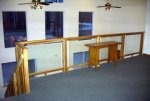- Location
- Massachusetts
Purpose of required outlets: Prevent fires by providing outlets where most likely used so people don't string long cords.
* example: countertop outlets are 4' apart versus wall outlets that are 12' apart.
Balance: Burden of installation versus the Likelihood of use.
* example: excluding sliding panels
Good design practice would place outlets along a loft that was wide enough to accomodate tables and chairs. Not all lofts do. Some are barely more than the space a staircase landing would provide. For those a floor receptacle would actually create a trip hazard that no one would ever use as an outlet. Minimum requirements would say no outlet required. Judgement should be in the hands of the designer according to the designed use of the area.
Again there is no difference in hazard between a wall without a receptacle or a railing as described by the OP without a receptacle.
In my opinion it is not up to the designer the code requires one along the railing described by the opening poster.


